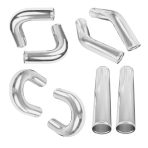Pipes & Fittings
Our Pipes, Bends & Fittings range covers the core building blocks for intake and exhaust fabrication. Choose aluminium tubes and mandrel bends for intercooler plumbing, or stainless/steel parts for exhausts—plus reducers, T/Y splits and clamps. Precise sizing, clean cuts and mandrel geometry speed up fabrication; we also consider v-band compatibility and Lambda (O2) bungs.
Summary and Key Benefits
This category helps you source the right pipes and fittings for performance-oriented builds. Carefully selected aluminium and stainless-steel parts provide accurate geometry and suitable wall thickness so flow losses are kept low while assembly remains straightforward. You will find straight lengths, bends from 30–180°, reducers, T and Y pieces and weld-on accessories such as Lambda (O2) bungs – all in one place.
Technical Basics
Aluminium tubes are typically made from weldable, heat-treated alloys (e.g. 6xxx series) that suit pressurised intake and turbo plumbing. Stainless parts usually come from 300-series or exhaust-grade 400-series materials, valued for heat resistance and corrosion performance. Bends are produced by mandrel forming to keep cross-section in the curve. Finishes range from raw and brushed to polished; after welding it is good practice to smooth the inner surface for better flow.
In terms of compatibility, the range covers turbo intake and full exhaust systems alike. With v-band joints, precise alignment matters; the v-band profile rings and clamps enable fast assembly and repeated disassembly. For Lambda (O2) sensors, weld-on bungs can be fitted and ideally positioned to avoid condensate pooling and to protect the wiring from heat.
Common pitfalls include galvanic corrosion when different metals touch, tight-radius bends that increase pressure drop, and poor deburring before welding. On intake/intercooler plumbing, missing bead rolling on tube ends may allow hoses to slip under high boost.
Selection Criteria
When sizing, balance the required flow capacity with the available space. For intake and intercooler pipework, aluminium offers low mass and favourable thermal behaviour; for exhaust sections, stainless steel is preferred for temperature capability and mechanical stability. Choose wall thickness according to expected pressure, vibration and support; shorter, well-braced runs can use thinner walls, whereas long or high-heat sections benefit from more robust construction.
Motorsport examples: on a Lada VFTS intake, the number and angle of bends strongly affect pulse behaviour; in time-attack cars the intercooler routing must minimise heat soak and pressure loss; in drift applications, v-band profile joints speed up service on hot exhaust segments. If adding a Lambda (O2) bung, plan for sensor access and cable protection.
For surface protection, consider heat shields around hot zones and coatings or heat-resistant paint on aluminium tubes. With rubber or silicone couplers always use quality clamps that match bead-rolled tube ends.
Installation & Maintenance
During fabrication, use a jig or template for accurate alignment. Prepare TIG welds with multiple tacks, then finish with a continuous bead; use back-purging where appropriate so the inner surface remains smooth. Align v-band rings coaxially so the clamp loads evenly. On intake systems, bead rolling plus correctly torqued clamps prevent hose blow-off under boost.
Before first start, perform a pressure or smoke test on intake plumbing, and check exhaust joints and hangers for leaks. In service, inspect for cracks from vibration, verify clamp condition and review Lambda (O2) sensor health. After heat cycles, re-torque fasteners and reassess heat shielding and adjacent wiring looms.
FAQ
Q: Should I choose aluminium or stainless steel?
A: For intake/intercooler use, aluminium is popular due to its low mass and thermal traits; for exhaust, stainless is preferred for durability and heat resistance.
Q: What bend angle works best?
A: Generally, a larger radius and fewer bends improve flow; the exact angle depends on packaging and the overall layout.
Q: Do I need bead-rolled ends on intake tubes?
A: Under boost, bead rolling is highly recommended to keep hoses from slipping even at high load.
Q: Where should I place the Lambda (O2) bung?
A: Typically between the manifold and the catalyst, oriented to avoid condensate pooling and shielded from heat.
Q: Why use v-band joints?
A: The v-band profile offers repeatable, leak-tight connections that greatly speed up exhaust service in demanding environments.



